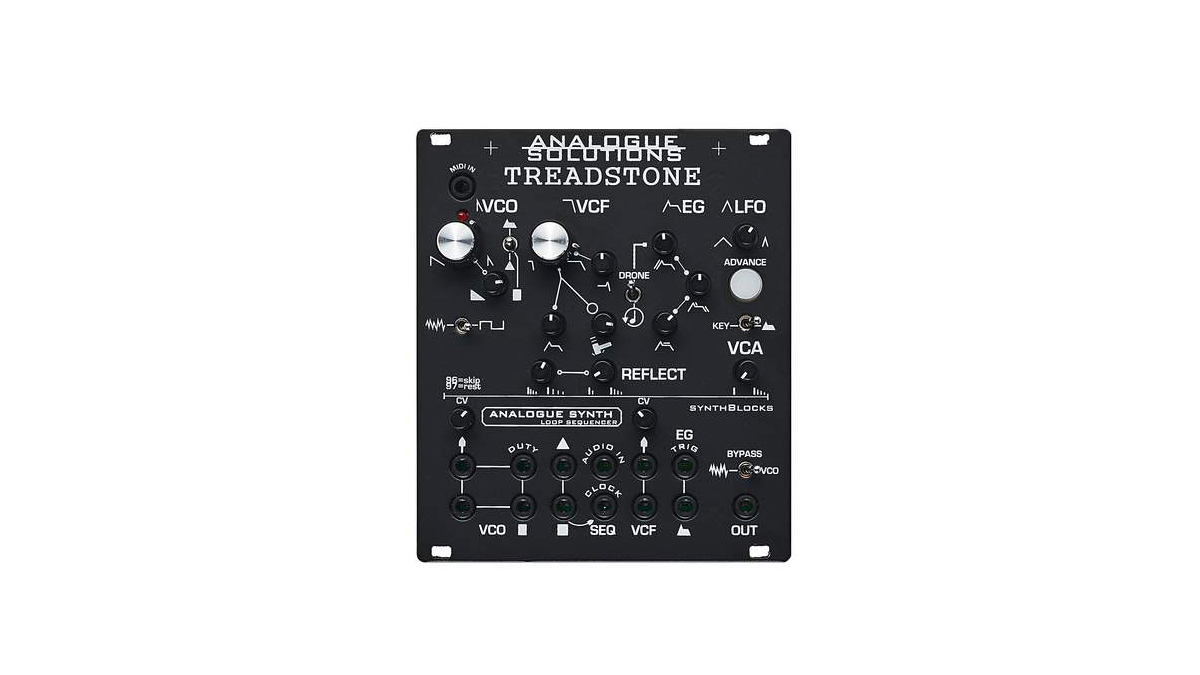MusicRadar Verdict
Retro-sounding synth voice takes the obvious step into modular territory - and, happily, actually feels a little more at home.
Pros
- +
Flexible 16-note step sequencer.
- +
Very capable sound for such a small package.
Cons
- -
A little too noisy at times.
- -
Interface is rather fiddly.
MusicRadar's got your back
Treadstone first appeared last year when it was released in Analogue Solutions’ SynthBlock format - a small, affordable desktop module - and when news of this Eurorack version of the single oscillator synth voice landed, we weren’t surprised, as it fits right in with its 12-point patchbay and slightly esoteric control layout.
On first inspection, the only apparent differences were that the faceplate features an ever-so slightly more subdued design and the obvious lack of wooden sides, enclosed back and rubber feet of the original enclosure. It is still the same self-contained analogue synth voice as before and it still includes the same 12V DC power socket on the board. However, this is not usable, as the power circuitry differs in the Eurorack edition; just a product of being manufactured at the same time as the desktop version.
The Treadstone’s voicing is tinged with a distinctly retro vibe, courtesy of the SSM2044 4-pole filter, which has been brought back into production and found on some classics through the years, such as the Korg Polysix and E-mu SP-1200. The two-waveform, single-oscillator design might put some people off for its apparent simplicity, but the Treadstone has plenty of tricks up its sonic sleeves.
Firstly, waveform selection is on a rotary, so can be blended from sawtooth to square wave. Secondly, there’s pulse-width modulation on the square wave, which can be modulated by either the envelope, or LFO. Thirdly, there’s an option to further beef up the tone with either noise, or a sub-oscillator, although there’s no level adjustment for either source.
Any self-contained synth voice wouldn’t be complete without some effects and the Treadstone duly obliges with a small smattering of reverb
In our previous review we felt the sub-osc level was a little too hot, but we’ve now come round to the idea of an extra layer of saturation in the low end. The Treadstone is a very capable little machine and, as with all semi-modular devices, patching in a variety of tones is possible; brash leads, evolving pads, some real gritty bass and drum sounds are all achievable.
However, one sticking point is the rather complex interface. Luckily, the online manual is on hand to help, but for some it may take a while to get used to. It’s also rather cramped, but in fairness it does pack a lot of features. The real boon is the 16-note step sequencer. You can use MIDI clock or incoming analogue clock for the tempo and notes are simply entered using MIDI note-on messages. Other triggering options on the Treadstone are the LFO and drone functions. The latter is a simple note-on affair while the LFO triggers the envelope in time with itself.
Any self-contained synth voice wouldn’t be complete without some effects and the Treadstone duly obliges with a small smattering of reverb. It’s very lightweight in control and effect. There’s little in the way of feedback that can be dialled-in, so your only option is to apply small amounts of splashy echo.
While it’d be nice to add more depth, the effect does add life to the patches. The decision to release two separate versions of the Treadstone seems odd. It’s not really a criticism, but it feels like a neater solution would’ve been to release the module with a desktop case that can be easily removed for Eurorack purposes - a la Behringer Neutron et al.
However, what we do have is a Treadstone module that is over £100 cheaper in Eurorack form and while not as feature-rich as the Neutron, it has a character of its own. The Treadstone makes more sense to us in this modular guise than in desktop form. The world of ‘affordable’ desktop modules is strewn with so many lower cost rivals that the TS could be overlooked in a sea of Korg Volcas, Roland Boutiques and Behringer remakes. However, in the bulging universe of Eurorack, the Treadstone is way more competitive. Not too many Eurorack synth voice modules can boast a 16-step sequencer and MIDI to CV conversion in only 22HP.
“For those on the hunt for a great quality 12-string electro-acoustic that won’t break the bank, it's a no-brainer”: Martin X Series Remastered D-X2E Brazilian 12-String review
“I have that on more records than anything else”: Take a peek inside Vaughn Oliver’s studio
“Wendy Carlos is able to build precisely the sound that she wants”: Watch synth pioneer Wendy Carlos in the studio, working Moog magic back in 1989










